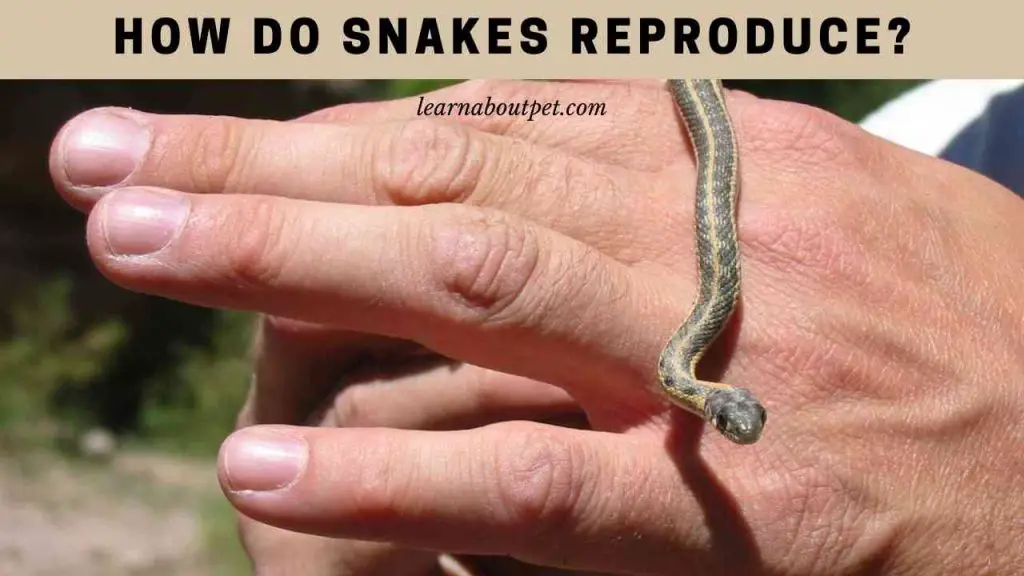People often express interest in knowing how snakes reproduce. In this article, you will find comprehensive information about snake reproduction – including how they actually breed, when they breed, how often they procreate and how you can breed your own snakes.
How do snakes reproduce? Most snakes reproduce sexually, but there are also a few that are able to reproduce asexually. Majority of snake species lay eggs, which then hatch into young snakes. But there are also a few that give birth to live young ones.
In the snakes that reproduce sexually, the first step is usually that of mating. After mating, the female snake may lay fertile eggs 28 to 45 days thereafter. Those eggs then hatch and develop into young snakes.
There are also some snakes where, after mating, the fertile eggs continue to develop inside the female’s body. She thereafter gives birth to live young snakes.

As for the snakes that reproduce asexually, this is usually possible through a process we refer to as parthenogenesis. That is a process where some female snake’s cells behave like sperm.
They therefore fertilize the eggs inside her, giving rise to clones.
Snake reproduction mostly takes place during the warmer seasons of spring and summer. That, in a nutshell, is how snakes reproduce. Let’s get into the details of it.
Do Snakes Reproduce Sexually Or Asexually?
A good place to start, in answering the how do snakes reproduce question, is by finding out whether they mostly reproduce sexually or asexually.
When you examine a snake, you find that it has no externally visible reproductive organs. This is what leads some people to speculate that snakes reproduce asexually.
It also leads to the are snakes asexual question (seeing that the snakes don’t have externally visible reproductive organs)?
But what is the true position? Do snakes reproduce asexually or sexually?
The true position is that most snakes reproduce sexually. There are few that are able to reproduce asexually. But how snakes breed, for the most part, is sexually.
True, snakes may not have reproductive organs that are externally visible. But their sexual organs are inside their cloacae.
So they do have sexual organs. It is just that the organs are concealed.
Snake reproduction, for the most part, is sexual. But asexual reproduction has also been observed in certain snakes.
For instance, the Brahminy blind snake almost always reproduces asexually.
Therefore if you have been having the how do snakes reproduce sexually or asexually question, now you have the answer. Most snakes reproduce sexually. But there are also a few that reproduce asexually.
But if you go through most of the how do snakes reproduce Reddit threads, you notice that the emphasis is mostly on the sexual reproduction.
This is understandable, because the sexual reproduction is the norm, whereas the asexual reproduction is an exception.
But going through the how do snakes reproduce Wikipedia article, you see that whereas the emphasis is still on sexual reproduction, they do also mention the asexual reproduction aspect.
How Do Snakes Reproduce Sexually?
Where snakes reproduce sexually, it always entails mating between male and female snakes.
In the course of mating, the male snake gets to fertilize the eggs in the female snake’s oviduct.
The female may thereafter lay fertile eggs or give birth to live young snakes.
Where the female lays the eggs, it is typically in shallow nests. She then leaves the eggs alone (in most species). But a few snake species stay on to guard the eggs.
The eggs then hatch into young snakes, which are born with all instincts they need to survive.
The snake hatchlings also get egg yolk reserves, which keep them going for the first days of their lives.
Where the female gives birth to live young ones, the development inside the mother takes longer. Then, when time to give birth comes, the young snakes come out through the snake cloaca.
The mother snake may then eat a few of the young ones she gives birth to, even as other get to survive.
How Can Snakes Reproduce Asexually?
The phenomenon where some snakes are able to reproduce asexually is a deeply fascinating one. People often express interest in knowing how exactly it happens.
So indeed, how do some snakes reproduce asexually?
In answering the how do snakes reproduce asexually question, we first need to acquaint ourselves with a phenomenon called parthenogenesis.
This is a phenomenon where some cells in a female snake’s body act like sperm. They are then able to fertilize eggs, just the way sperm from a male snake would do!
The cells in question are known as polar bodies. They are special, in that when they mature, they can act as sperm – and therefore be capable of fertilizing the female snake’s eggs.
There is one type of snake, which we refer to as the blind Brahminy snake, which is only able to reproduce asexually.
But even in the snakes that reproduce sexually, there are rare accounts of some of them reproducing asexually on occasion.
In all cases of snake reproduction eggs have to be fertilized. It is only that in the case of asexual reproduction, the fertilization is done by cells from the female itself: giving rise to clones.
Therefore if you have been having how do snakes breed asexually question, now you have the answer. It is through a process where some cells, inside a female snake, behave like sperms – and thereby proceed to fertilize eggs inside her.
But that question – on how to snakes breed asexually in some cases has another angle. That is where a snake may be able to store sperm from previous mating sessions.
Then it uses that sperm to fertilize eggs at a later date. So it gives birth even without mating.
Obviously, this is not true asexual reproduction.
How Do Snakes Mate?
While answering the how do snakes reproduce question, one of the key areas we need to focus on is that of how snakes mate.
That is because, as we have seen, snake reproduction is mostly sexual.
Therefore how snakes mate is something we need to have good insight into, within this context.
So, indeed, how do snakes have sex? Or, as some may be inclined to put it, how do snakes fuck?
The first step in snake mating is where the females leave pheromones, telling any available males that they are ready for mating.
The second step is where the male snakes court the females. If there are many males competing for one females, a snake mating ball forms in the process, as each male tries its chances.
The third step is where the female snake lifts its tail, thus exposing its cloaca. Then the male snake then wraps its tail onto the female’s tail.
If you check any how snakes mate diagram, it is likely to show the male and female snakes’ tails wrapped.
At this point, the male’s two penises, known as the hemipenes penetrate the female’s cloaca. He then releases sperm, which go up the female’s cloaca to the oviduct, to fertilize the eggs therein.
If you look at any how do snakes reproduce video, it is likely to show the males hemipenes in the female’s cloaca. That is if it is a closeup video.
But when it comes to a simple diagram how do snakes reproduce illustration, it is likely to simply show the male and female’s tails wrapped.
So the mating entails the female releasing pheromones, the male courting the female, then the male inserting his hemipenes into the female’s cloaca and thereafter releasing sperm to fertilize eggs.
How Do Snakes Mate And Lay Eggs?
This is another key angle to examine, while exploring the how do snakes reproduce question.
The main issue here is, how do snakes fertilize eggs that ultimately hatch into baby snakes?
And the answer is that the mating entails the female snake lifting its tail, and the male snake wrapping its tail around the female’s tail.
Thereafter, one or both of the male snake’s two penises (hemipenes) enter the female snake’s cloaca. The male then releases sperm into the cloaca.
The sperm goes up the cloaca, into the oviduct, to fertilize the eggs that happen to be there.
The female then lays eggs – usually 28 to 45 days after the mating.
And the eggs thereafter hatch: usually around 2 months after laying.
How Do Snakes Mate And Give Birth?
This is also a crucial element in exploring the broader how do snakes reproduce question.
So the key issue here is, how do snakes get pregnant (which subsequently leads to them giving birth)? Therefore what we need to understand is how to snakes get pregnant?
What first happens is that the female snakes release pheromones, which indicate their readiness to mate.
Thereafter, the male snakes court the females. If a female proves receptive, it will lift its tail, giving the male access to its cloaca.
The male then inserts his hemipenes into the female’s cloaca, and thereafter releases sperm to fertilize the eggs that are in the female’s oviduct.
So this is how snake get pregnant, after which it may proceed to give birth to live young baby snakes. That is if it is of one of the species that give birth to live young ones, rather than laying eggs.
How Do Snakes Mate In The Water?
Some snakes, for instance sea snakes, live in the water. This leads to an interesting question: how do snakes reproduce in water?
Or more specifically, how does a snake have sex in water?
How snakes have sex in water is, in many ways, similar to how they have sex on land.
The actual copulation entails the male inserting his hemipenes into the female’s cloaca, then releasing sperm which fertilize the eggs in the female’s oviduct.
So that the female that is being mated with doesn’t drift away, the male nudges her neck on his, using his snout.
So if you have been having the how do snakes have sexually fertilized reproduction in water, that is the answer.
After mating, the sea snakes typically proceed to give birth to live young ones – as opposed to laying eggs. Latidcaudids are the only sea snakes known not to give birth to live young ones.
How Do Snakes Lay Eggs?
In exploring the how do snakes reproduce question, the next aspect we need to pay attention to is the egg laying aspect.
So, indeed, how do snakes reproduce eggs?
The snake eggs are produced in the snake’s ovaries. They may then travel to the oviduct, which is where they are fertilized, and where they grow until they are ready for laying.
When time comes to lay the eggs, they come out through the cloaca. The mechanism that makes it possible for the eggs to come out is that of muscle contractions.
The snake will typically lay the eggs in a shallow nest. The eggs have mucus covering, which ensures that they don’t roll away.
Inside the eggs is yolk, which has food reserves to keep the snake hatchling going for the first days of its life.
One may ask, how does the snake get pregnant with eggs? And the answer is that this happens when the eggs are released from the snake’s ovaries.
Once the eggs are in the snake’s oviduct, if they get sperm from a male snake, they become fertile.
The snake lays the eggs between 28 and 45 days after mating.
Then after around 2 months, the snakes hatch – giving rise to baby snakes.

How Do Snakes Give Birth?
Earlier, in answering the how do snakes reproduce question, we saw that some lay eggs while others give birth to live young ones.
This leads to the question on how snakes give birth (for those that do).
The answer is that the snakes give birth through their cloacae. So the baby snakes come out through the cloacae.
Snakes don’t give birth through their mouths, as some people mistakenly believe. The babies come out through the cloacae.
The cloaca is of course also the opening through which poop and other waste comes out.
One may then ask, how do snakes poop using the very same opening that they give birth through?
The answer is that, whereas the cloaca is one opening, internally it is connected to different pathways.
The pathway through which poop comes out is very different from the one through which eggs/babies come out.
So this is similar to asking, how do snakes reproduce venom using the very same mouths that they eat through.
You find that whereas the venom comes out through the mouth, it is actually produced in the salivary glands in the backside of its head.
All in all, when it comes to giving birth, the baby snakes come out through their mothers’ cloaca.
Common garter snakes are among those that give birth to live young ones in this way. So if you have been wondering, how do garter snakes reproduce, now you have the answer.
When Do Snakes Breed?
Any attempt to answer the how do snakes reproduce question won’t be complete if we don’t venture to find out when they breed.
The true position is that snakes usually breed during the warmer seasons of spring and summer.
But snakes in the tropics, where temperatures are more or less stable all year round, are able to also breed throughout the year.
Which Snakes Reproduce Asexually?
Earlier, while answering the how do snakes reproduce question, we discovered that some reproduce asexually.
This leads to the question on which ones actually reproduce asexually.
The answer is that the blind Brahminy snake is the only one that is known to consistently reproduce asexually.
But some of the snakes the reproduce sexually may also reproduce asexually on occasion. Examples include copperheads, some types of boas and pit vipers.
When Are Snakes Ready To Mate?
Quite often, the people posing the how do snakes reproduce question may express interest in knowing when the snakes are ready to mate.
So, when are snakes ready to mate? The answer is that snakes are ready to mate when they reach sexual maturity.
For most types of snakes, this is at 2-3 years. But there are others for whom the age of maturity is in the 4-5 years range.
How Often Do Snakes Reproduce?
A natural extension to the how do snakes reproduce is this one – on how often snakes reproduce.
As it turns out, most snakes breed either once or twice per year.
That leads to another question: how fast do snakes reproduce? The answer is that the rate of reproduction depends on the number of eggs a snake lays or the number of young ones it gives birth to.
It also depends on how many of the young ones actually survive.
There are some snakes that may lay as few as 3 eggs, and others that may lay as many as 100.
Similarly, for those that give birth, the number of young snakes it gives birth to may be as few as 10 and as many as 30.
Can Different Types Of Snakes Reproduce?
Another natural extension to the how do snakes reproduce question is this one – on whether different types of snakes can reproduce.
The true position is that snakes that are closely related may be able to interbreed.
For instance, snakes in different subspecies may be able to breed.
Most often, when different types of snakes breed, they give rise to hybrids that are fertile – unlike most other animals’ hybrids.
How Can You Tell Male From Female Snake?
Snakes don’t have externally visible reproductive organs. This is in fact what often leads people to pose the do snakes have reproductive organs at all question?
But the true position is that snakes do have sexual organs: only that they are not externally visible. The organs are in their cloacae.
In most species, the females are usually bigger than the males. But the males have thicker tails.
Therefore if you have two snakes of the same species, yet one is smaller but has a thicker tail, it is likely to be the male.
The only way to tell a male from a female for sure is through cloacal probing. This entails inserting a lubricated prone into the snake’s cloaca. If it is a male, you will feel a hemipenes blocking the probe.
But this sort of probing is best done by a veterinarian doctor. Otherwise one may end up hurting the snake.
How Do You Breed Snakes?
After exploring the how do snakes procreate subject, one may express interest in knowing how do snakes breed and understand difference between species of snakes..
The first step in breeding snakes is to find healthy males and females.
Then the second step is to provide the female with adequate heat, which will make it receptive to a male.
Once you notice that the female is ready for a male (like when it relaxes and lays still in the presence of a male), allow mating to take place.
Provide the female with a suitable nesting spot. Then, once the female lays eggs, separate them from her: lest she starts eating some them.
You may then put the eggs in an incubator, until they hatch.
For the snakes that give birth to live young ones, the most important thing is to watch out for whether the female becomes pregnant after mating.
Then once she gives birth to young ones, separate her from them – lest she decides to eat some of them.
Final Verdict – How Do Snakes Reproduce
Most snakes reproduce sexually, though there are also a few that reproduce asexually.
In those that reproduce sexually, the reproductive process starts with mating. After that, the female may lay eggs or give birth to live young ones.
In those that reproduce asexually, what happens is that some cells in the female’s body act as sperm. So they fertilize the eggs inside her, giving rise to clones.
It is possible to breed snakes: by getting compatible males and females, allowing them to mate, then incubating the eggs until they hatch.

If you are breeding breeds that give birth to live ones, all you need to do, after mating, is to allow enough time for the female to go through the pregnancy and give birth to the young ones.
While breeding snakes, once you get the snake young ones or hatchlings, it is essential to separate them from their parents. Otherwise the parents may be inclined to eat some of them.
Snakes mostly breed during the spring and summer. That is with the exceptions of in the tropics, where the snakes tend to reproduce all year round.
As a pet lover, make sure to learn about pet more and give your pet snake a good and comfortable life!

Welcome to Learn About Pet. My name is Rajkumar Ravichandran and I love all pets, travel, and amazing food. I write about my passion and personal experience caring for multiple pets in this blog! ❤️
Post Disclaimer
DISCLAIMER: THIS BLOG OR WEBSITE, "Learn About Pet", DOES NOT PROVIDE YOU WITH MEDICAL ADVICE AND IS NOT A SUBSTITUTE FOR MEDICAL ADVICE. ALWAYS GET IN TOUCH WITH YOUR PERSONAL VETERINARIAN AND USE INFORMATION HERE AS GENERAL ADVICE.
The information, including but not limited to, text, graphics, images and other material contained on this website are for informational purposes only. No material on this site is intended to be a substitute for professional veterinary advice, food recommendation, diagnosis, or treatment. Always seek the advice of your veterinarian or other qualified health care provider with any questions you may have regarding a medical condition or for pet food related questions.







